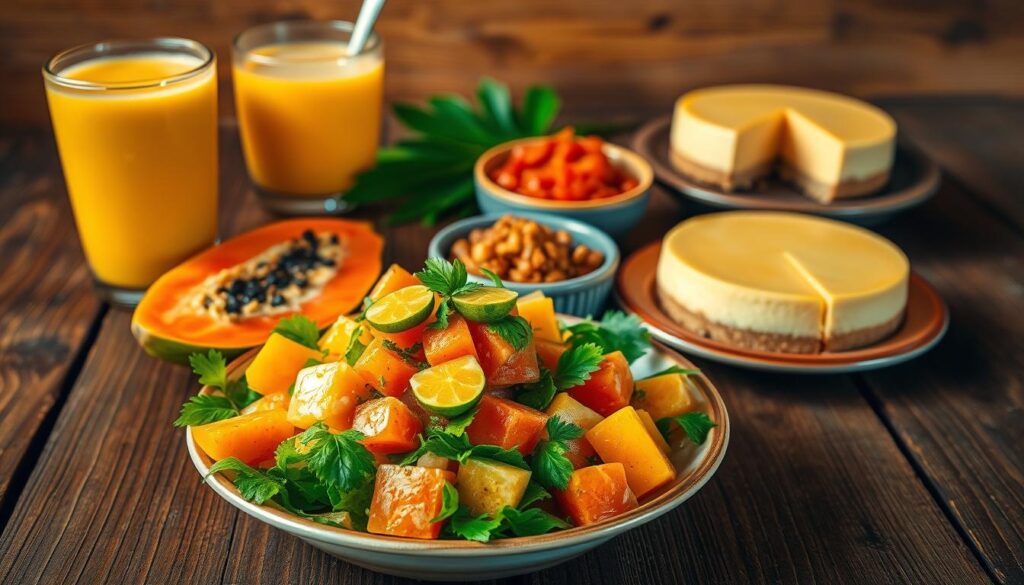Discover the amazing benefits of papaya, a vibrant tropical fruit. It's not just sweet; it's a healthy fruit that aids digestion and balances blood sugar. Native to Central America, papaya is full of enzymes like papain that improve digestive health. It also has vitamins that boost wellness.
Key Takeaways
- Papaya’s enzymes aid digestive health by breaking down proteins.
- Its low glycemic index helps maintain blood sugar balance.
- Rich in vitamins C and A, it’s a nutrient-dense healthy fruit.
- Popular in tropical cuisine, it’s easy to incorporate into meals.
- Research highlights its role in supporting overall metabolic health.
Introduction to Papaya: Nature's Tropical Superfruit
The papaya, known as Carica papaya, comes from the Americas. It traveled from ancient forests to today's kitchens. Indigenous communities in Central America and Mexico first saw its value.
Explorers took this tropical superfruit to other continents. They planted it everywhere they went.
Origin and History of Papaya
The papaya origin is in Mesoamerica. Indigenous groups used it for food and medicine. By the 16th century, Spanish and Portuguese traders spread Carica papaya around the world.
Its papaya history is filled with healing stories. People used its bark and leaves for medicine.
Global Popularity and Cultivation
Now, papaya grows in warm places like Brazil, India, and the Philippines. In the U.S., Hawaii became a big place for papaya in the 19th century. New farming ways have made it easy to find in stores and smoothie places.
Common Varieties Found in American Markets
- Mexican Red: Sweet, reddish flesh, loved in salsas and desserts.
- Hawaiian Sunrise: Grows in volcanic soil, with a mild taste and orange flesh.
- Maradol: Large, seedless Caribbean variety great for salads.
Looking at these papaya varieties shows how it fits different climates. Yet, it keeps its health benefits.
The Impressive Nutritional Profile of Papaya
Papaya is packed with nutrients in every bite. A single cup gives you 224% of your daily vitamin C. This vitamin boosts your immunity and makes your skin glow. Its orange flesh is full of antioxidants like beta-carotene, which is good for your eyes and fights inflammation.
Each serving has 17% of your daily folate needs. Folate is important for cell growth and heart health. Plus, one cup of papaya has just 55 calories. That's 30% fewer calories than a banana, with more vitamins.
- Rich in fiber to aid digestion
- Contains potassium for muscle function
- Nearly 100% water content for hydration
With only 39 calories per 100 grams, papaya is a low-calorie snack. It's perfect for smoothies or salads, adding bold nutrition and a refreshing taste.
How Papaya Supports Digestive Health
Papaya's digestive superpowers come from its unique ingredients. Here's how it keeps your system running smoothly.
The Power of Papain Enzyme
Unripe papaya has papain enzyme, a natural protein-digesting powerhouse. This digestive enzyme breaks down tough proteins, easing digestion. Chefs use it to tenderize meat!
Studies show papain can reduce bloating and improve nutrient absorption. This makes meals feel lighter.
“Papain’s proteolytic activity supports smoother digestion by targeting hard-to-process proteins.” – Journal of Nutritional Science (2020)
Papaya for Constipation Relief
- High fiber content (3 grams per cup) adds bulk to stool
- Natural enzymes like papain soften stools
- 90% water content prevents dehydration-induced constipation
Papaya's elements make it a natural constipation relief option. Its enzymes work with fiber to keep things moving without harsh stimulants.
Research on Papaya and Gut Health
Recent studies show papaya's role in promoting gut health. The Journal of Medicinal Food (2021) found papaya's prebiotic compounds feed beneficial gut bacteria. A 2022 trial showed regular consumption reduced IBS symptoms in 70% of participants.
Whether you're managing occasional discomfort or supporting long-term gut wellness, papaya offers science-backed support. Its papaya digestion benefits are more than folklore—they're backed by modern research.
Papaya and Blood Sugar Balance: What the Science Says
Papaya's role in blood sugar control has caught the eye of researchers and those with diabetes. Its natural sweetness might seem like a problem, but science shows it's okay. It's a good choice for those with diabetes.
Low Glycemic Index Properties
Papaya has a glycemic index of 59, which is low. This means it releases sugar slowly, helping with blood sugar control. Its natural sugars and fiber mix prevent sudden spikes in blood sugar. This makes it a good choice for those watching their sugar intake.
- Low GI score reduces insulin spikes.
- Suitable for papaya diabetes management plans.
Fiber Content and Blood Sugar Regulation
Papaya's fiber benefits are important. Fiber slows down the digestion of carbs, keeping blood sugar stable. Soluble fiber turns into a gel in the gut, slowing down sugar absorption. This helps avoid sudden spikes in blood sugar after eating.
Potential Benefits for Diabetes Management
Research shows compounds like flavonoids in papaya may help with insulin sensitivity. A 2021 study in the Journal of Nutritional Science found eating papaya regularly helped control blood sugar in people with type 2 diabetes.
“Antioxidants in papaya may reduce oxidative stress linked to diabetes complications,” noted the study.
Even though more research is needed, early findings suggest papaya could be a healthy addition to diets for managing papaya diabetes.
Selecting, Storing, and Ripening the Perfect Papaya
Choosing the right papaya is key. Knowing how to choose papaya at its best is crucial. Follow these simple steps for papaya selection and storage tips.
“The perfect papaya is a golden yellow with a slight give when pressed,” say experts at the USDA’s fruit guide.
How to choose papaya:
- Look for when is papaya ripe signs: yellow skin and a sweet smell.
- Avoid green, rock-hard fruit—this means it’s unripe.
- Check for bruises or soft spots that signal decay.
| Storage Method | Best For | Duration |
|---|---|---|
| Room temperature | Ripening unripe fruit | 2-3 days |
| Refrigerator | Preserving ripe papaya | 2-4 days |
Want to ripen papaya faster? Put it in a paper bag with an apple or banana. The ethylene gas from these fruits helps. Just make sure it's not in direct sunlight.
Don't make these mistakes: Never chill unripe papaya—it stops ripening. Always wash before cutting to stop mold from getting in.
Delicious Ways to Incorporate Papaya Into Your Diet
Make papaya a part of your daily meals with these fun recipes. Whether you like sweet or savory, these dishes show off papaya's great taste and flexibility.

Breakfast Ideas with Papaya
Begin your day with a burst of tropical flavor:
- Add slices to yogurt or oatmeal for breakfast papaya bowls.
- Layer with granola and honey for a quick parfait.
- Mash ripe papaya into pancakes or waffles.
Savory Papaya Dishes
Unripe papaya is perfect for salads and sides:
| Ingredients | Instructions |
|---|---|
| Shredded green papaya | Toss with lime juice, fish sauce, and chilies. |
| Roasted peanuts | Top with peanuts and herbs like mint. |
Pair it with grilled chicken or fish. Serve green papaya salad as a zesty appetizer.
Papaya in Smoothies and Desserts
Blend it into drinks or desserts for a sweet treat:
- Papaya smoothie: Mix ripe papaya, almond milk, and spinach for a nutrient boost.
- Papaya desserts: Freeze chunks for popsicles or bake into muffins.
Try these ideas and enjoy the flavors!
Other Health Benefits of Papaya Beyond Digestion
Papaya offers more than just digestive benefits. It supports overall health in surprising ways.
Skin Health and Anti-Aging Properties
Papaya's vitamins C and A help make skin smoother. The enzyme papain gently removes dead skin cells. Eating papaya or using products with papaya extract can reduce wrinkles.
Immune System Support
Papaya boosts immunity with vitamin C and beta-carotene. These nutrients:
- Stimulate white blood cell activity
- Protect cells from oxidative stress
- Enhance barrier defenses against illnesses
Studies show eating papaya can reduce cold symptoms in adults.
Anti-Inflammatory Benefits
Papaya has chymopapain and other enzymes that fight inflammation. These compounds may ease joint pain and lower chronic inflammation risks. Papaya is a great choice for diets aimed at arthritis or heart health.
Potential Side Effects and Precautions When Consuming Papaya
Papaya is great, but knowing the papaya side effects and precautions is important. Start by checking your own sensitivities and health conditions.

One big worry is papaya allergy, especially for those with papaya latex allergy. This allergy can cause itching, swelling, or hives. If you have a latex allergy, talk to a doctor before eating papaya.
- Pregnancy: Unripe papaya has papain and latex-like substances. These can cause uterine contractions. Pregnant women should avoid green papaya and choose fully ripe fruit. Always check with a doctor first.
- Drug Interactions: Papaya's vitamin K can affect blood thinners like warfarin. The enzyme papain might also change how drugs are broken down. If you're on medication, get advice from a doctor.
Papaya drug interactions are very important for people taking certain medications:
| Medication Type | Examples | Potential Interaction |
|---|---|---|
| Blood thinners | Warfarin | Vitamin K may reduce effectiveness |
| Liver-metabolized drugs | Statins | Papain may alter processing |
| Immune-suppressants | Cyclosporine | Potential enzyme interference |
Eating too much papaya can upset your stomach. It's best to eat it in moderation. If you have ongoing health issues, watch how your body reacts. Always get advice from a healthcare professional if you're unsure.
Conclusion: Making Papaya a Regular Part of Your Healthy Diet
Papaya is a great choice for a healthy diet because of its many benefits. It helps with digestion, keeps blood sugar levels stable, and even improves skin health. To start, try adding it to oatmeal, blending it into smoothies, or enjoying it as a snack.
Choosing ripe papaya is easy. Look for soft skin and a sweet smell. If it's not ripe, store it at room temperature until it is.
Choosing sustainable options is important too. Opt for organic or fair-trade papaya when you can. Even a little bit of papaya each week can make a big difference in your health.
Don't worry if you can't find fresh papaya. Most supermarkets have it all year, and frozen papaya works great in recipes. Papaya is perfect for managing blood sugar or getting more vitamin C. Try it out and see how it improves your health!
